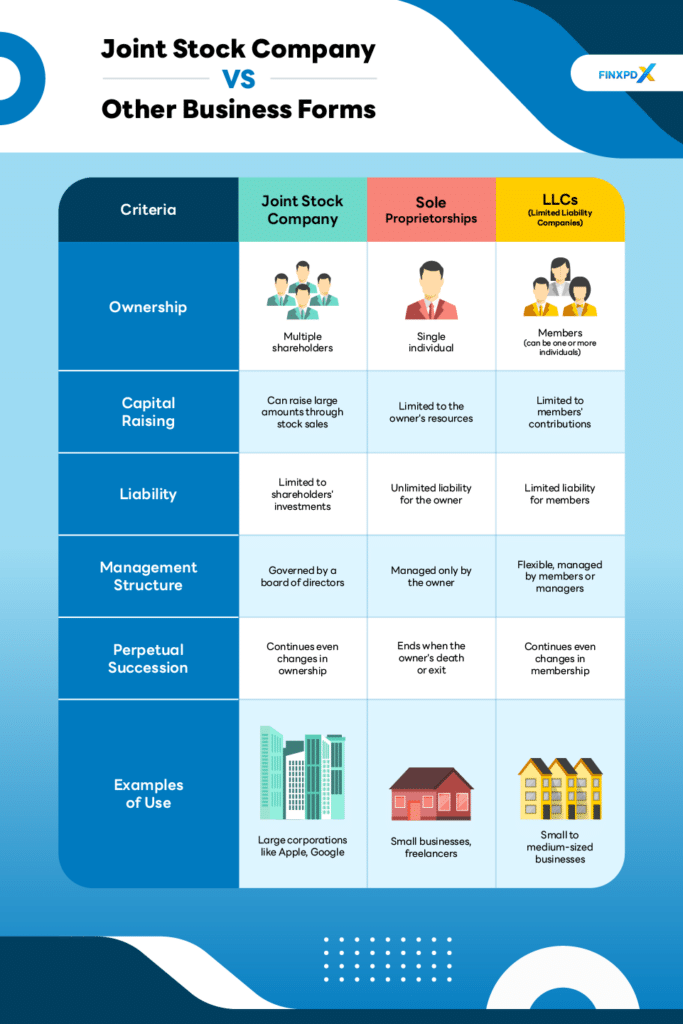
Choosing the right business structure is a critical decision for any entrepreneur, and one compelling option to consider is a joint stock company. This company type is a unique business structure that offers several advantages for entrepreneurs and investors. Unlike sole proprietorships or partnerships, it allows for pooling resources from multiple shareholders. It is an attractive option for those looking to invest in or start a business with the potential for substantial growth while minimizing personal financial risk.
In this article, we will investigate the details of a joint stock company, its features, advantages, disadvantages, and how they compare to other business forms.
What Is Joint Stock Company?
A joint stock company is a type of business which capital is divided into shares owned by individual shareholders. The shareholders have the flexibility to transfer their shares, allowing them to buy and sell their stocks freely. This represents ownership and entitles them to profits typically paid as dividends. Its structure allows the company to raise capital by issuing public or private investors shares. The company typically limits each shareholder’s liability to the amount invested, providing a layer of financial protection. It operates under a structured management system, overseen by a board of directors, to goals and regulations while protecting shareholders’ interests.
⚠️Tip: Shareholders also have the right to vote on important company matters.
Key Takeaways
- A joint stock company is a business entity owned by shareholders who invest capital in exchange for shares.
- Joint stock company is subject to regulatory compliance, ensuring transparency and accountability.
- Joint stock company allows for the transfer of ownership through the buying and selling of shares.
- Profits of joint stock company are distributed to shareholders as dividends, based on the number of shares held.
- Joint stock company often have better access to loans and credit due to their established credibility.
Features of Joint Stock Company
A joint stock company is a popular business organization with several defining features that make it suitable for large-scale enterprises and various investment opportunities. Here are the main features:
Limited Liability: The company limits each shareholder’s liability to the amount they have invested. This means that the company protects the shareholders’ personal assets from its debts and liabilities.
Transferability of Shares: Shares of a joint stock company are freely transferable, allowing shareholders to sell their shares or buy more without significant restrictions.
Perpetual Succession: A joint stock company’s existence is not affected by changes in its ownership or the death of its shareholders. It remains a legal entity until the appropriate authorities legally dissolve it.
Separate Legal Entity: It is recognized as a separate legal entity from its owners. It can own property, enter into contracts, and sue or be sued using its own name.
Capital Accumulation: This company’s structure allows it to raise substantial amounts of capital by issuing shares to the public. This makes it easier to fund large projects and expansion plans.
Types of Joint Stock Company
Share Offering
Joint stock companies are primarily classified into two main types based on their ability to offer shares and the level of regulatory oversight. Here are the main types:
Public Limited Company (PLC): PLCs can sell shares to the public through a stock exchange, allowing unlimited shareholders. They face strict regulations, including mandatory financial disclosures and minimum capital requirements before offering shares to the public.
Private Limited Company (Ltd): Ltd companies have restricted share transfers, typically limited to a maximum of 50 shareholders. They cannot sell shares to the public or list on a stock exchange and face fewer regulatory requirements, making them suitable for small to medium sized enterprises.
Formation and Regulatory
The formation and regulatory framework can categorize joint stock companies. Here are the three main types:
Registered Company: To form a registered company, individuals must register under the relevant companies act of a country and adhere to the regulations and requirements set forth by the governing act. Most modern corporations, including those listed on stock exchanges, fall under this category.
Chartered Company: A monarch or head of state establishes chartered companies by granting a royal or special charter, often for specific purposes. Historically significant examples include the British East India company and the Hudson’s Bay company.
Statutory Company: The legislature or parliament creates statutory companies through a specific act. This act outlines their purpose, powers, and regulations. These companies typically provide public utility services or other essential activities mandated by the government. Examples include national railways and water supply companies.
Advantages of Joint Stock Company
A joint stock company provides benefits like financial protection for shareholders and the ability to raise significant capital, making it attractive for investors and entrepreneurs. These are the primary advantages:
Limited Liability: The company limits shareholders’ liability to the amount they have invested, protecting their personal assets from business debts and liabilities.
Access to Capital: It can raise significant capital by issuing shares to the public, which facilitates large-scale business operations and expansions.
Transferability of Shares: Investors can easily buy and sell shares in this company type, and also providing liquidity and flexibility.
Enhanced Credibility: It often have greater credibility with banks, suppliers, and customers due to their regulated structure and transparency requirements.
Economies of Scale: The ability to raise large amounts of capital allows for investment in efficient production processes and technologies, leading to cost savings and competitive pricing.
Risk Diversification: With many shareholders, the company spreads out the risk, reducing the impact on individual investors and providing a more stable financial base.
Disadvantages of Joint Stock Company
Despite its benefits, a joint stock company has drawbacks such as regulatory burdens, potential loss of control, and complex formation processes. These are the primary advantages:
Complex Formation: Establishing this company type involves complex legal procedures and documentation, which can be time-consuming and costly.
Regulatory Compliance: It must adhere to stringent regulations and reporting requirements, which can be burdensome and expensive to maintain.
Loss of Control: Founders and original owners may lose control over the company due to the widespread ownership of shares and the influence of large shareholders.
Double Taxation: Profits of this company type incur taxes at both the corporate level and the individual level when dividends are distributed to shareholders.
Short-Term Focus: Shareholders often prioritize short-term financial gains over long-term strategic goals, which can negatively impact the company’s sustainable growth.
Risk of Hostile Takeovers: The free transferability of shares makes it are at risk of hostile takeovers if someone buys a majority of the shares.
Joint Stock Company vs. Other Business Forms
This comparison table outlines the key differences between joint stock company and other business entities such as partnerships, sole proprietorships, and limited liability companies (LLCs). Its purpose is to help you understand their unique characteristics and benefits
| Criteria | Joint Stock Company | Partnerships | Sole Proprietorships | LLCs (Limited Liability Companies) |
|---|---|---|---|---|
| Ownership | Multiple shareholders | Multiple partners | Single individual | Members (can be one or more individuals) |
| Liability | Limited to shareholders’ investments | Shared liability among partners | Unlimited liability for the owner | Limited liability for members |
| Capital Raising | Can raise large amounts through stock sales | Limited to partners’ contributions | Limited to the owner’s resources | Limited to members’ contributions |
| Management Structure | Governed by a board of directors | Managed by partners | Managed only by the owner | Flexible, managed by members or managers |
| Regulatory Requirements | Extensive regulatory compliance | Less regulatory burden compared to corporations | Minimal regulatory requirements | Moderate regulatory requirements |
| Perpetual Succession | Continues even changes in ownership | Dissolves if a partner leaves or dies | Ends when the owner’s death or exit | Continues even changes in membership |
| Examples of Use | Large corporations like Apple, Google | Small to medium-sized businesses | Small businesses, freelancers | Small to medium-sized businesses |
Conclusion
In summary, a joint stock company is a business structure that offers a unique blend of benefits, making it a strong choice for large-scale enterprises and investors. It provides limited liability, access to significant capital, and perpetual succession, which are attractive features for business growth and stability. However, it also comes with challenges such as complex formation procedures, strict regulatory compliance, and potential loss of control. Understanding these factors and comparing it to other business forms helps entrepreneurs make informed decisions that align with their goals and resources.
FAQs
A joint stock company is a business entity where capital is divided into shares, and shareholders can buy and sell these shares. It combines the features of partnerships and corporations, offering limited liability and share transferability.
A joint stock company is formed by registering with the relevant governmental authority. It involves creating a memorandum of association and issuing shares to raise capital. Legal formalities and requirements may vary by country.
Shareholders own the company and have voting rights in major decisions, such as electing the board of directors. They receive dividends and can sell their shares. However, the board of directors typically handles day-to-day management.
Yes, a joint stock company can go public by listing its shares on a stock exchange. This allows the general public to buy and sell shares. We know this process as an initial public offering (IPO).
Yes, a joint stock company can issue various types of shares, such as common shares, preferred shares, and convertible shares. Each type offers different rights, privileges, and dividend policies.
Related Articles:
- Angel Investors: Fund Sources for New Businesses
- Stock Split: Advantages and Risks You Should Know
- Unlisted Equity Shares: Its Potential in the Shadows
- Primary vs. Secondary Market: Its Important Concept
Read more: Stocks








